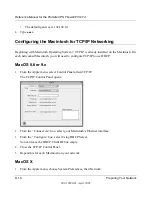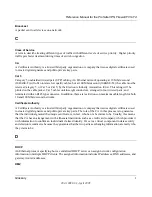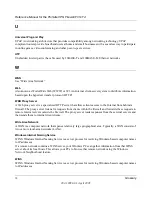
Reference Manual for the ProSafe VPN Firewall FVS114
2
Glossary
202-10098-01, April 2005
AES
AES stands for Advanced Encryption Standard. AES is a symmetric key encryption technique that will
replace the commonly used Data Encryption Standard (DES). Not only does AES provide more security
than DES and 3DES, it also has better performance, making AES highly attractive for use in constrained
environments.
It was the result of a worldwide call for submissions of encryption algorithms issued by the US
Government's National Institute of Standards and Technology (NIST) in 1997 and completed in 2000.
AES provides strong encryption and has been selected by NIST as a Federal Information Processing
Standard in November 2001 (FIPS-197). The U.S. Government (NSA) announced that AES is secure
enough to protect classified information up to the top secret level, which is the highest security level and
defined as information which would cause "exceptionally grave damage" to national security if disclosed to
the public.
The AES algorithm uses one of three cipher key strengths: a 128-, 192-, or 256-bit encryption key
(password). Each encryption key size causes the algorithm to behave slightly differently, so the increasing
key sizes not only offer a larger number of bits with which you can scramble the data, but also increase the
complexity of the cipher algorithm.
ARP
Address Resolution Protocol, a TCP/IP protocol used to convert an IP address into a physical address (called
a DLC address), such as an Ethernet address. A host wishing to obtain a physical address broadcasts an ARP
request onto the TCP/IP network. The host on the network that has the IP address in the request then replies
with its physical hardware address. There is also Reverse ARP (RARP) which can be used by a host to
discover its IP address. In this case, the host broadcasts its physical address and a RARP server replies with
the host's IP address.
Auto Uplink
Auto Uplink
TM
technology (also called MDI/MDIX) eliminates the need to worry about crossover vs.
straight-through Ethernet cables. Auto Uplink
TM
will accommodate either type of cable to make the right
connection.
B
Bandwidth
The information capacity, measured in bits per second, that a channel could transmit. Bandwidth examples
include 10 Mbps for Ethernet, 100 Mbps for Fast Ethernet, and 1000 Mbps (I Gbps) for Gigabit Ethernet.
Baud
The signaling rate of a line, that is, the number of transitions (voltage or frequency changes) made per
second. Also known as line speed.
Содержание FVS114NA
Страница 4: ...202 10098 01 April 2005 iv...
Страница 12: ...202 10098 01 April 2005 xii Contents...
Страница 16: ...Reference Manual for the ProSafe VPN Firewall FVS114 1 4 About This Manual 202 10098 01 April 2005...
Страница 116: ...Reference Manual for the ProSafe VPN Firewall FVS114 6 28 Advanced Virtual Private Networking 202 10098 01 April 2005...
Страница 148: ...Reference Manual for the ProSafe VPN Firewall FVS114 9 8 Troubleshooting 202 10098 01 April 2005...
Страница 166: ...Reference Manual for the ProSafe VPN Firewall FVS114 B 16 Network Routing and Firewall Basics 202 10098 01 April 2005...
Страница 200: ...Reference Manual for the ProSafe VPN Firewall FVS114 D 22 Preparing Your Network 202 10098 01 April 2005...
Страница 211: ...Reference Manual for the ProSafe VPN Firewall FVS114 Glossary 11 202 10098 01 April 2005...
Страница 212: ...Reference Manual for the ProSafe VPN Firewall FVS114 12 Glossary 202 10098 01 April 2005...





































